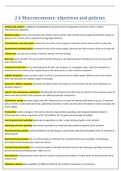Summary
Summary A* revision notes for 2.6 macroeconomic and objectives; economics a level edexcel
- Institution
- PEARSON (PEARSON)
A* revision notes, detailed anaylsis and evaluation to ensure you hit those top marks. Get yourself into the higher bands. These will allow you to stop being stuck in those lower bands. covers: 2.6.1 possible macroeconomic objectives 2.6.2 demand side policies 2.6.3 supply side policies 2.6...
[Show more]



